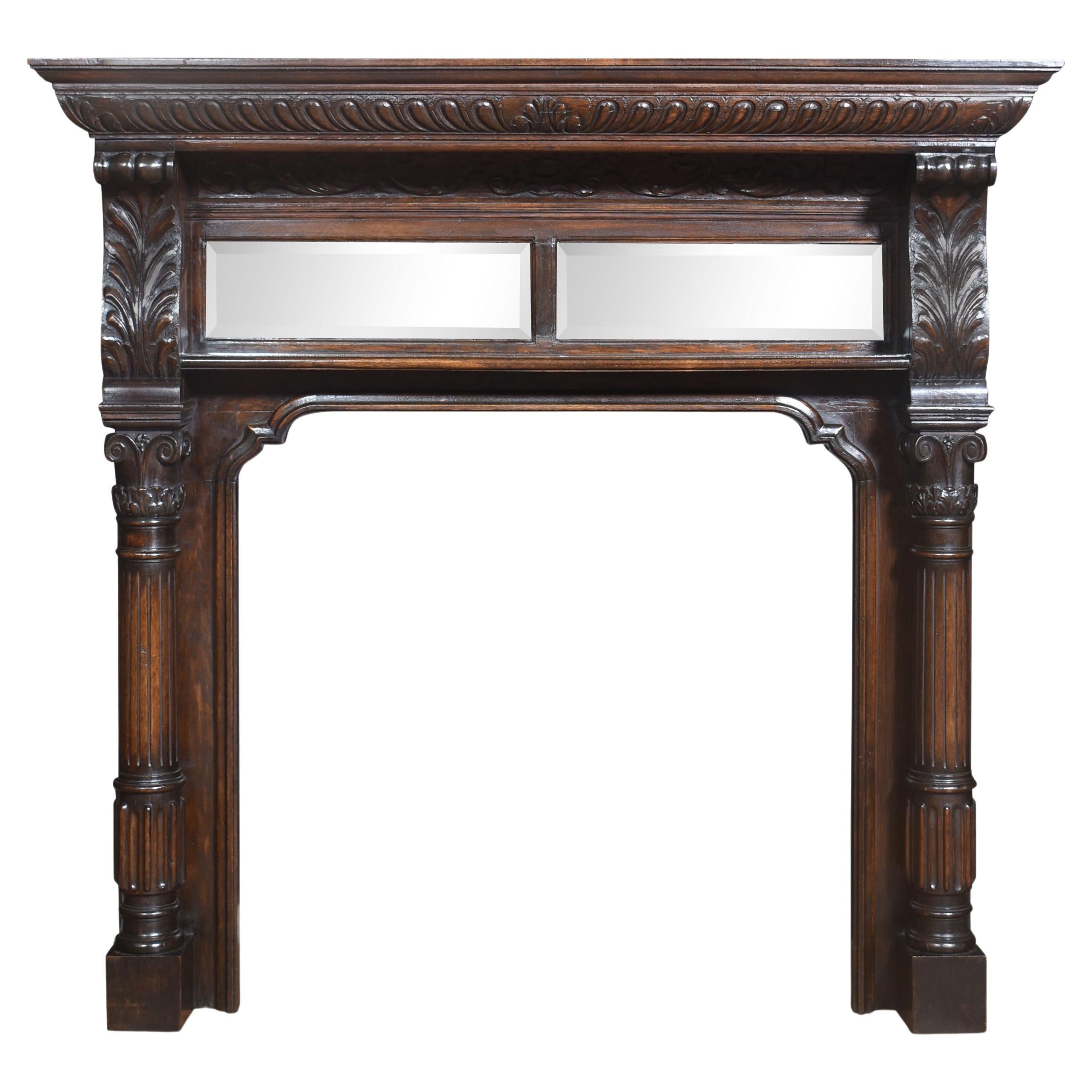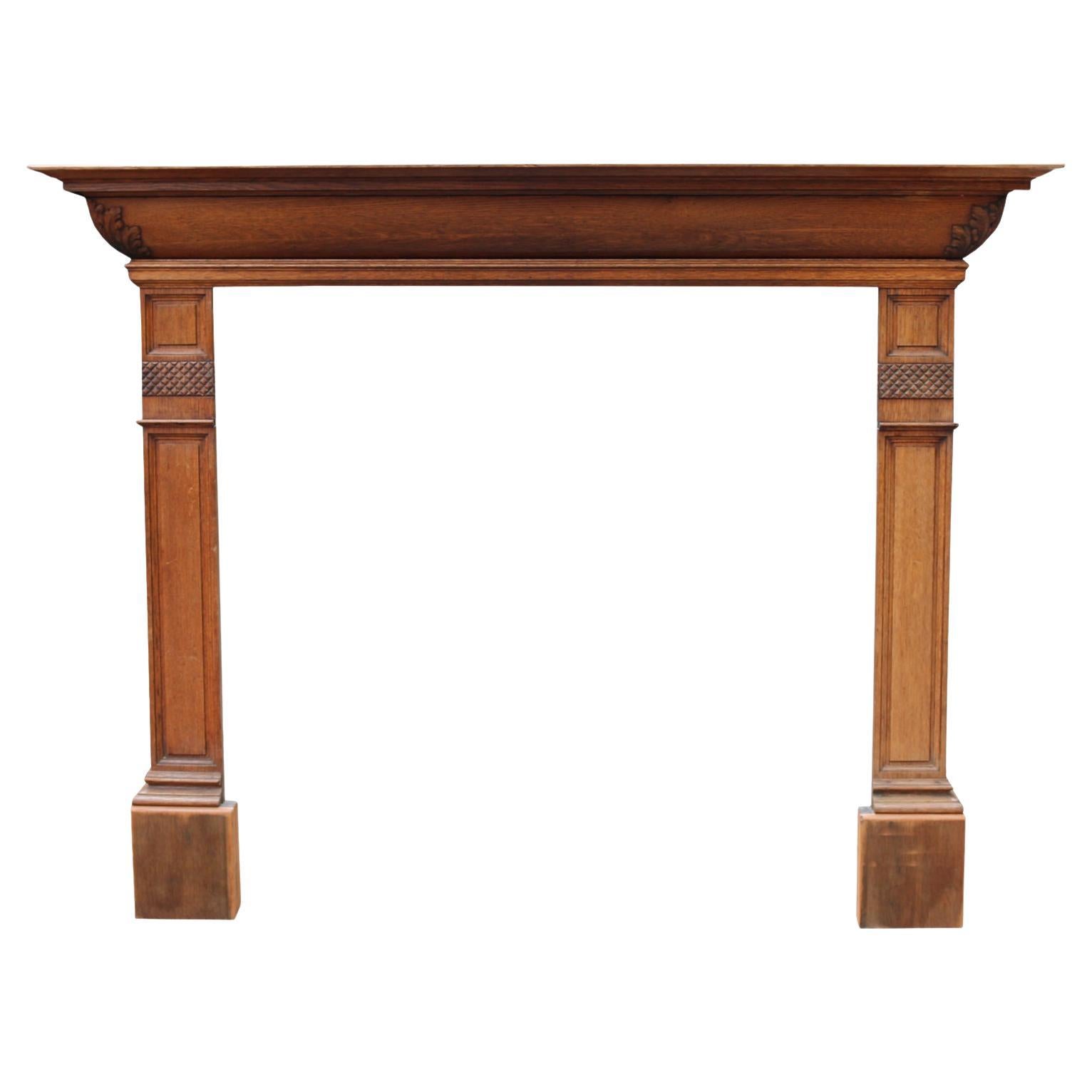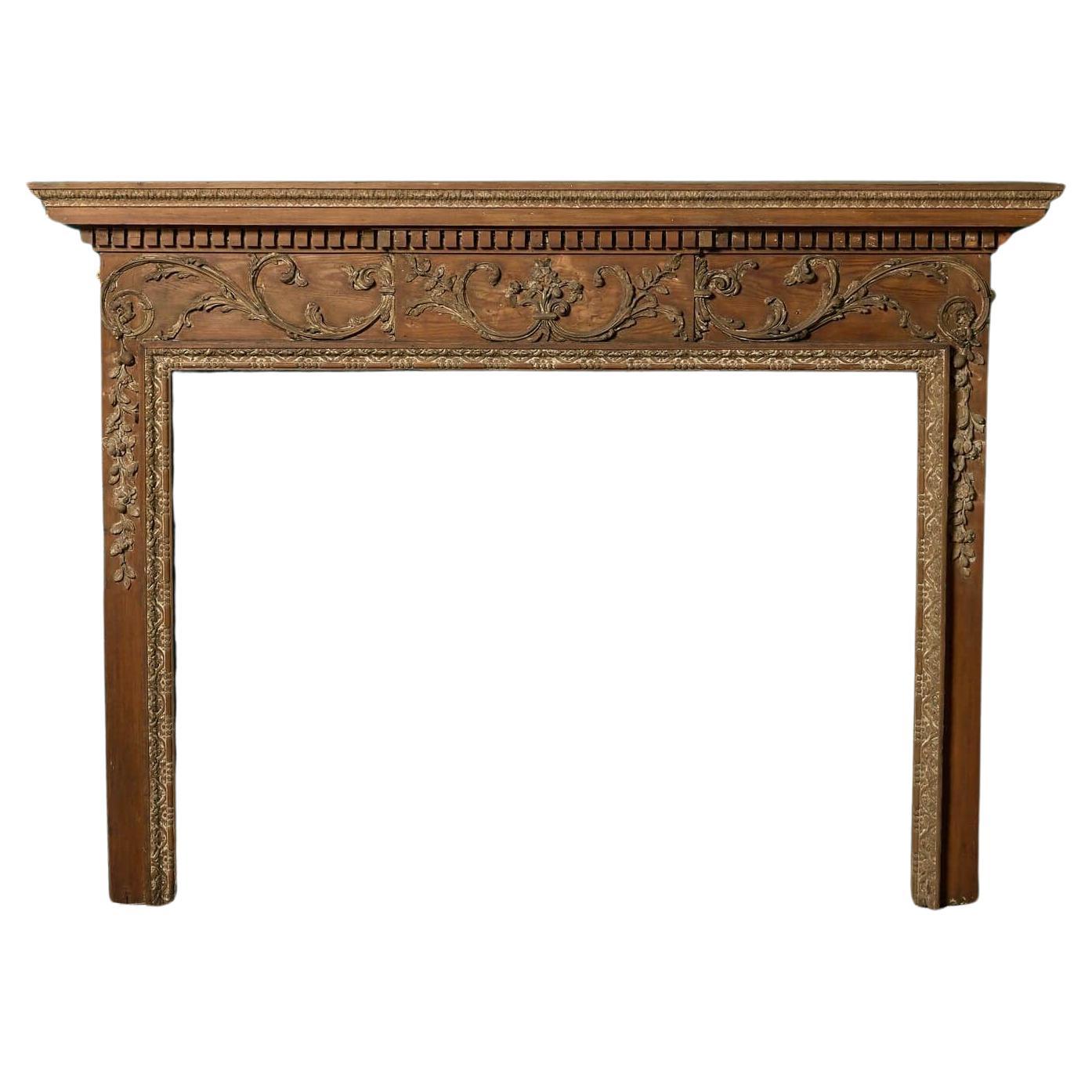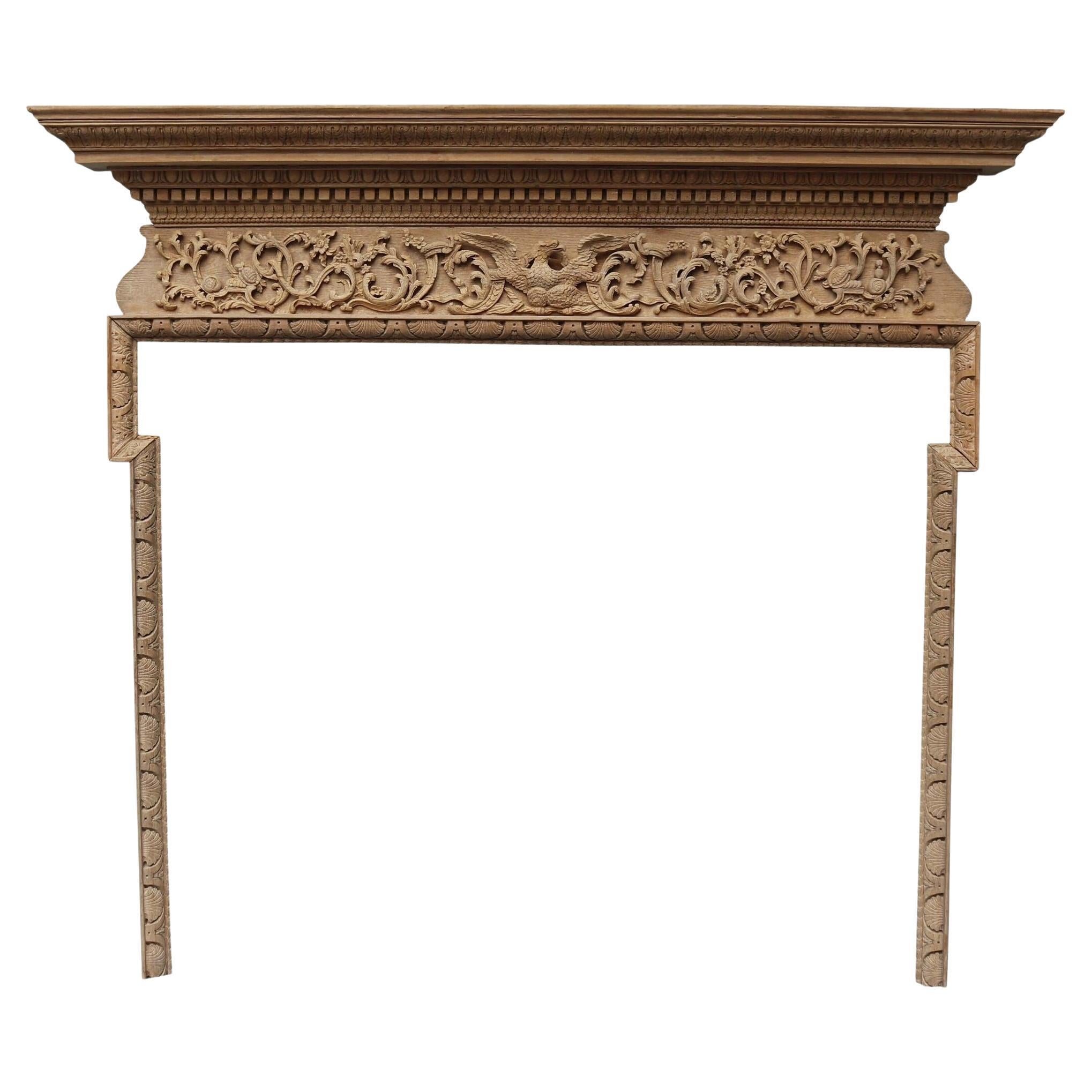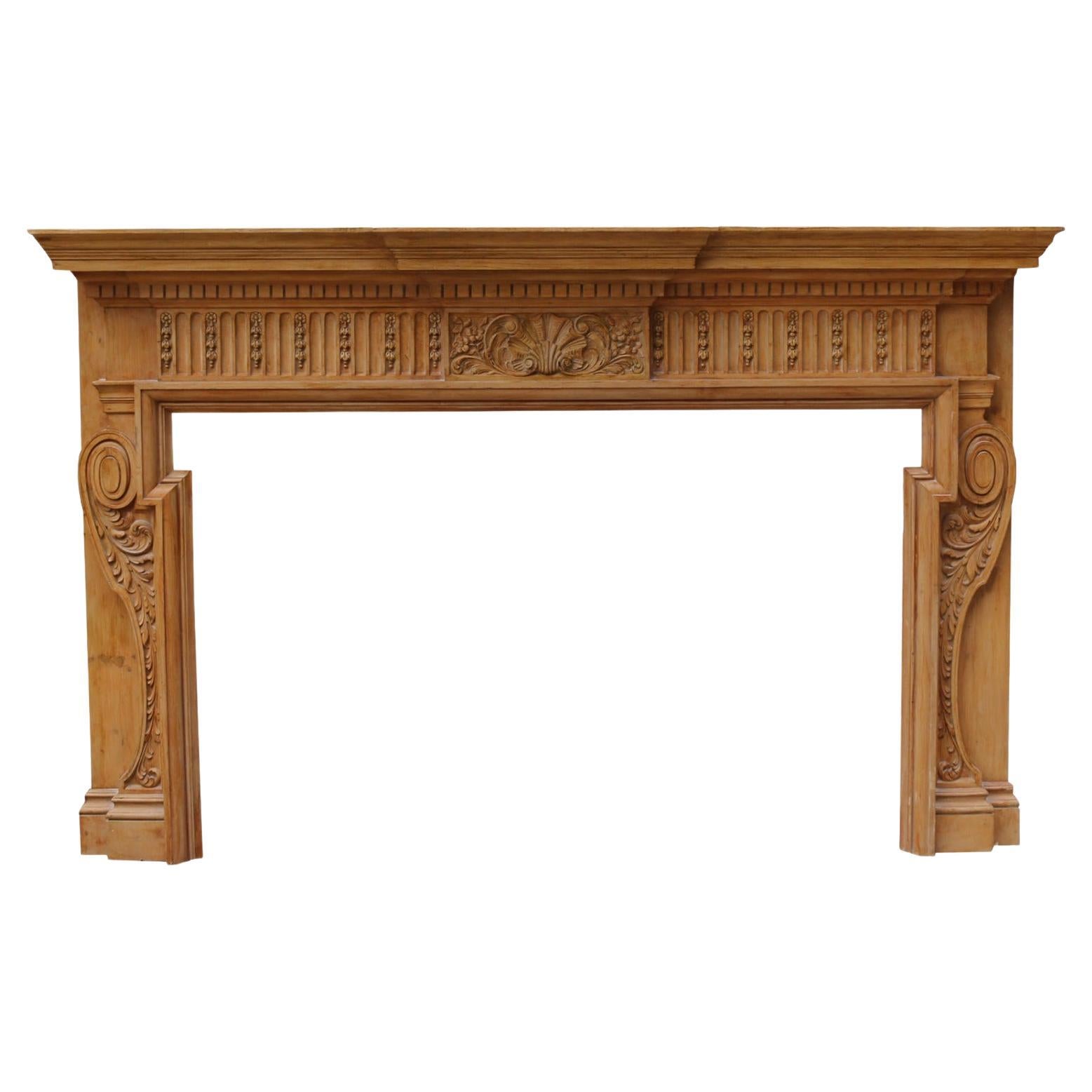Items Similar to A carved fire surround from Sir Winston Churchill’s drawing room
Want more images or videos?
Request additional images or videos from the seller
1 of 6
A carved fire surround from Sir Winston Churchill’s drawing room
About the Item
A carved fire surround from Sir Winston Churchill’s drawing room. This carved pine fire surround combines elements of both Rococo and Palladian designs. It has a shaped cornice above a frieze of foliate arabesques and floral garlands centred on a raised panel of confronting C-scrolls, leaves and flowerheads. The supports have recesses at the corners and the whole inner edge is decorated with a gadrooned border. English, circa 1910.
Provenance: 28 Hyde Park Gate, London, home of Sir Winston and Baroness Churchill from 1945 until Sir Winston’s death in 1965
Literature: Knight, Frank and Rutley The London Home of the late Sir Winston Churchill, K.G., O.M., C.M., and of Baroness Spencer-Churchill G.B.E., 28 Hyde Park Gate together with 27 Hyde Park Gate auctioned 28th October 1965 (the fire surround pictured in situ in the drawing room of number 28)
Country Life, 2nd September 1965 illustrated in an advert for the above sale.
Illustrated London News, 5th December 1959 cover featured the Churchills in the drawing room at No. 28 to celebrate Sir Winston’s 85th birthday.
28 Hyde Park Gate was built in 1842 and described, by the Bayswater Chronicle in 1945, as ‘a pleasant red-brick house, which has three reception rooms and nine or ten bedrooms’ on which ‘a lot of money has been spent’. However, after losing the general election of 1945, Churchill bought 28 Hyde Park Gate as a London base (his other home being Chartwell, in Kent and immediately had it redecorated. One room was assigned as what he called his ‘snob library’ of beautifully bound books. The walls were hung with pictures of his aristocratic ancestors, who included the Ist Duke of Marlborough, victor of the Battle of Blenheim. The following year he also purchased number 27, next door, for £7,000, originally for use as office accommodation. He later had the two houses combined and they formed his longest standing London residence. (English Heritage.)
- Dimensions:Height: 53.5 in (135.89 cm)Width: 67 in (170.18 cm)Depth: 6.75 in (17.15 cm)
- Materials and Techniques:
- Place of Origin:
- Period:1910-1919
- Date of Manufacture:Circa 1910
- Condition:Wear consistent with age and use.
- Seller Location:Lymington, GB
- Reference Number:1stDibs: LU973036767002
About the Seller
5.0
Recognized Seller
These prestigious sellers are industry leaders and represent the highest echelon for item quality and design.
Established in 1982
1stDibs seller since 2013
106 sales on 1stDibs
Typical response time: 4 hours
Associations
LAPADA - The Association of Arts & Antiques Dealers
- ShippingRetrieving quote...Ships From: Lymington, United Kingdom
- Return PolicyA return for this item may be initiated within 14 days of delivery.
More From This SellerView All
- A bronze portrait of Sir Winston Churchill by Rufus Martin, 2023Located in Lymington, HampshireA bronze portrait of Sir Winston Churchill by Rufus Martin, 2023 This head and shoulders bronze bust is instantly recognizable as Sir Winston Churchill. He is wearing a British Warm greatcoat with epaulettes and has a half-smoked cigar in the left hand resting on his hip. His right hand is raised in his trade mark V-for-Victory salute. Signed ‘Rufus Martin 1/12’. Sir Winston Churchill (1874 –1965) was a British politician, army officer and writer. He was the Prime Minister of the United Kingdom from 1940 to 1945, when he led Britain to victory in the Second World War, and again from 1951 to 1955. Churchill represented five constituencies during his career as a Member of Parliament. Ideologically an economic liberal and imperialist, for most of his career he was a member of the Conservative Party, which he led from 1940 to 1955, but from 1904 to 1924 was a member of the Liberal Party. This portrait of Churchill by Rufus Martin is striking for its juxtaposition of this famous historical subject and the free and contemporary choice of presentation. Churchill’s tenure during the Second World War infused the nation with calm and confidence, providing the British people with strong leadership during its darkest hours. Martin succeeds in portraying Churchill’s unshakeable belief in a successful outcome for the Allies through his defiant stance, unwavering gaze and Victory V gesture. Together with the recognizable “Bulldog” facial features and broad shoulders, this bust captures the subject in terms of character as well as being an accurate physical portrait . Rufus Martin trained at Wimbledon College of the Arts, London, though his aptitude for 3D design and sculpture was apparent from a very young age. His mother, a portrait painter, showed him the portrait sculptures of Augusta Savage, Jacob Epstein and Augustine Rodin, which inspired him to create a bust of his late mentor, Michael Howells. He sculpts ‘intriguing individuals, always hoping to capture some element of their past or current struggles and to create something for the good of the community they inhabit and wherever possible for posterity’ – an ambition he has most successfully fulfilled with this powerful portrait. After leaving college in 2017, with first class honours, Martin has won many prestigious prizes including the Tiranti Prize at the FACE, the Signature Art Award, the Chelsea Arts Club show for ‘Amy’, the True Blue Show, the Salmagundi Open Show, New York, Green & Stone Summer Show, the Chelsea Arts Society Summer Show, RBA Rising Stars, the Royal Cambrian Academy Open, the Binny Mathews & Sons joint show, The Next Big Thing and has been published in the Kings House...Category
2010s English Busts
MaterialsBronze
- A pair of Sir Winston Churchill glass decanters, by Garrard & Co., 1974Located in Lymington, HampshireA pair of Sir Winston Churchill glass decanters, by Garrard & Co.,1974. These lead crystal decanters are numbers 27 and 28 in a limited editio...Category
Vintage 1970s English Glass
MaterialsGlass
- George III Steel Fire DogsLocated in Lymington, HampshireAn antique pair of George III steel fire dogs. These steel fire dogs have front supports shaped like short tongs with urn and baluster finials.Category
Antique Early 1800s English George III Fireplace Tools and Chimney Pots
MaterialsSteel
- A George III carved pine chimneypiece from The Marine Society by Tousey, 1775Located in Lymington, HampshireThis pine chimneypiece has a swan-neck pediment supporting three pedestals, with dentil and leaf borders. There is a central limewood oval portrait of Robert Marsham, 2nd Baron Romney carved in relief and suspended by acanthus and tied ribbons. The frieze below is also applied with limewood carving of naval trophies, emblematic of seamanship and learning, flanking a central tablet depicting a reclining Marine Society boy. The supports are composed of large fluted columns with Ionic capitals and edged with egg and dart borders and leaf-carved mouldings. English, 1775. Provenance: Supplied by Mr. Tousey for the Committee Room of the Marine Society at No. 54 Bishopsgate Street, London, in April 1775 at a cost of £30.15s 6d removed to Clark’s Place, Bishopsgate Street, London, in 1891 Published: Woodman, Richard “…..of daring temper 250 years of the Marine Society.” London 2006, pp 24-25. Bosanquet, Henry T. A., The Marine Society, A Catalogue of the Pictures and other Works of Art, 1905, p. 14. The Marine Society is the world’s oldest public maritime charity and was the brainchild of Jonas Hanway. In 1756, at the beginning of the Seven Years’ War, he reflected on Britain’s woefully undermanned and ill-equipped navy. His idea was to ensure that young men and boys who wished to ‘learn the duty of seaman…shall be handsomely clothed and provided with bedding, and their charges born down to the ports where His Majesty’s Ships lye with all other proper encouragement.’ During the ensuing hostilities the Society equipped 5,140 men and 4,787 boys for the Navy. In 1793 Admiral Lord Nelson, a governor of the Society, requested 20 lads to join his 64-gun ship Agamemnon at Chatham. By the Battle of Trafalgar in 1805, at least 15% of British naval manpower was being supplied, trained and equipped by the Marine Society. By 1774, the Society had outgrown its offices in the Royal Exchange and moved to 54 Bishopsgate Street. Detailed minutes of the weekly Committee meetings describe the furnishing of the Society’s new Committee Room, including ‘a carved chimneypiece...Category
Antique 1770s English Fireplaces and Mantels
MaterialsPine
- An original portrait drawing by Sir Stanley Spencer of Daphne Spencer, his nieceLocated in Lymington, HampshireAn original portrait drawing by Sir Stanley Spencer of Daphne Spencer, his niece (and reputedly his lover), finely drawn with the sitter looking slightly to the right, pencil on car...Category
20th Century English Drawings
MaterialsPaper
- An oak inkwell carved from Lutine timber, dated 1799Located in Lymington, HampshireThis large and historically interesting inkwell, or standish, is carved from timber recovered from the wreck of H.M.S. Lutine. It has a central inkwell, with a bud and oakleaf cover...Category
Antique 1860s Nautical Objects
MaterialsOak
You May Also Like
- Carved oak fire surroundLocated in Cheshire, GBCarved oak fire surround, the rectangular mantle above carved detail. to the acanthus capitals flanking two original bevelled mirrors. Supposed on bold reeded carved pillars. Dimensi...Category
Early 20th Century British Fireplaces and Mantels
MaterialsOak
- Victorian Carved Oak Fire SurroundLocated in Wormelow, HerefordshireAn elegant Victorian surround with barrel frieze and panelled jambs. Opening Height 120 cm Opening Width 122 cm.Category
Antique Late 19th Century Fireplaces and Mantels
MaterialsOak
- Georgian Carved Pine Fire SurroundLocated in Wormelow, HerefordshireA large Georgian period pine fire surround, reclaimed from a London townhouse. Highly decorative, the wide shelf is highlighted with lambs tongue carving and dentils above carved scr...Category
Antique Late 18th Century English Georgian Fireplaces and Mantels
MaterialsPine
- Old Impressive Generously Carved Pine Fire Surround / Mantle from EnglandLocated in North Salem, NYImpressive old generously hand carved pine fire surround mantle from England. Opening 41"W 36"H.Category
20th Century English Fireplaces and Mantels
MaterialsPine
- English Georgian Carved Pine Fire SurroundLocated in Wormelow, HerefordshireEnglish Georgian Carved Pine Fireplace. A decorative and deeply carved fireplace carved with fruits and foliage. The frieze carved with an eagle centrepiece, foliage and pomegranates...Category
Antique Mid-18th Century Fireplaces and Mantels
MaterialsPine
- Antique Georgian Style Carved Pine Fire SurroundLocated in Wormelow, HerefordshireThis fire surround has a stripped and waxed finish. Measures: Opening height 81 cm Opening width 125 cm Width between iutside of legs 169.5 cm.Category
Antique Late 19th Century Fireplaces and Mantels
MaterialsPine
Recently Viewed
View AllMore Ways To Browse
George Iii Fire Grate
72marble Fireplace
Small French Marble Fireplace Mantel
Georgian Cast Iron Insert
Dentil Mantle
Victorian Arch Fireplace Cast Iron
White Carrara Statuary
Antique Victorian Combination Fireplace
Antique Federal Mantel
Bluestone Mantel
Cat Mantel
Egyptian Fireplace Surround
Copper Fireplace Insert
Wood Federal Mantel
Antique Copper Fireplace Insert
Antique Marbleized Slate Fireplace
Breccia Viola Marble
Breccia Viola
